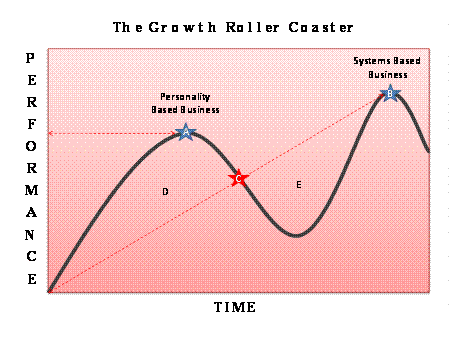To
understand why growth slows or stagnates in any business, we first need to look
at how a typical business evolves and why the frustration starts to mount as
this growth slows. We call this the ‘Growth Roller-Coaster’.
Take
a look at the illustration below.
The
starting point is the beginning of a business, usually created by a sole
proprietor or a small partnership/directorship. Typically, the owners are very
hands-on at this stage with few, if any, staff and modest resources. In the
early months and years the business grows very well.
Customers
receive a high degree of director attention with high levels of expertise and
customer-care as a result. Costs in the modest operation are relatively low and
the business can respond quickly to customer and market needs.
Word
is spread by customers and referrers about the great, cost-effective products
or services and new business is easily gained. The business quickly expands to
a peak at point A, driven by the personalities and skills of its owners.
In
an ideal world, two conditions will now be met. Firstly, the directors will
recognise that they have reached the pinnacle for a personality-driven business
and secondly, the business and financial performance will be at a level that
completely satisfies them. In reality, neither is the case.
What
happens in the real world is that the owners continue to drive forward.
However, with growth problems materialise…
Staff
and resource levels have been increased to serve the growing customer base,
increasing costs and tying up director time. The owners themselves come under
increasing time pressure, being torn between customer, staff and business
needs. Falling service levels and rising costs see the growth constricted and
dissatisfaction around the business grows in its place.
Have
you ever heard yourself or a colleague say, “This was so much easier in the
early days!”
Now
the owners find themselves at point C. Right now, you are likely to be at some
point between A and C.
Reality
has dawned and the business is at a crossroads.
Do
you remain a personality-driven business and attempt to claw your way back to
point A by downsizing, culling customers and laying off staff and try and raise
point A to a higher point?
Or,
do you undertake the investment (mostly in time and effort) required to move
forward and become a systems-based business at point C. I guess as you’re taking
this course, it’s highly likely this is what you want to achieve.
Interestingly
both types of business can be successful with the right planning and
management. But, too many businesses find themselves falling into the trough in
between simply because they’ve didn’t consider early enough what their
fundamental strategies and goals should be.
Instead
emphasis is placed on the process functions of the business like, delivering
the product or service and support to customers and essential marketing and
management of the business is overlooked. Growth, consequently, is limited.
Let’s
look then at the high-level view of your business (which can be any business).
As I mentioned earlier, it has three key components…
1.
Process
The
mechanics by which any business ‘produces’ its saleable products or
services. This is how you generate
income.
2.
Marketing
The
generation of new customers, the retention of existing customers and the
maximisation of customer value. This is
how you acquire and retain customers and this course focuses on this particular
component.
3.
Management
The
running of the business – its performance management, strategies and goals as
well as the financial management of your business (where we come in!). This is
where you generate profit and wealth.
When a
business is growing steadily and reaching the owner-managers’ objectives, the 3
functions work together to create a harmonious cycle (see diagram below)
In
reality, the majority of people in business are taught process skills from
school days, through skills training and onwards.
We
are taught how to read and write. How to follow instructions and answer
questions. How to replicate what we learn. You develop expertise in how to do
‘things’.
In
other words, your expertise and skills invariably lie in the PROCESS function.
Consequently, with the skills and knowledge loaded towards the Process
function, businesses can only grow whilst there is capacity within the Process
function to do so.
But
without the same relative development in the management and in particular
marketing functions either side, growth becomes limited…
The
cycle now starts to look very different (see diagram below).
So
the solution is simple…
You
need to start putting more effort into the marketing and management functions
of the business to realign the balance.
This
doesn’t mean you neglect the process function.
It
just means you work smarter and allocate your time and effort better to include
these two crucial areas of your business.
So,
there is little doubt as to why most businesses do not achieve the growth
objectives the directors or partners have set
and why now is the time to make the transition from a process-led business
to a management- and, in particular, a marketing-led business.
Our
goal is for you to have a systems-based business that’s set up to achieve your
objectives. In each issue of blog series, we’ll do our best to give you
everything you need in order to achieve this goal.
APJ Accountancy - Together We Will Make It Happen
Phone us on 020 89310165 Now!




No comments:
Post a Comment